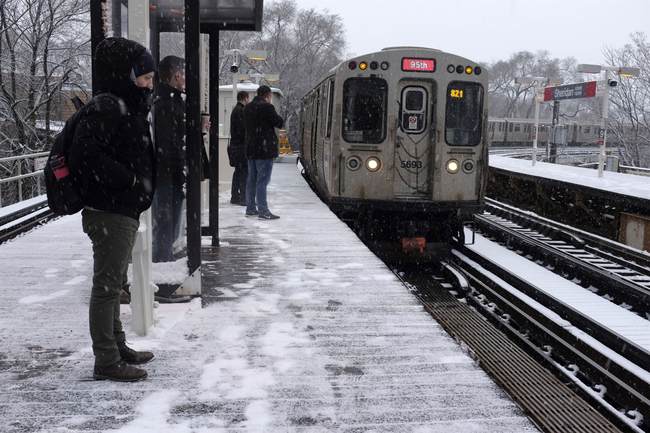Chicago’s public transportation system may prohibit weapons on its property, but the Chicago Transit Authority’s trains, buses, and stations are anyhing but “gun-free.” Assaults involving assailants armed with knives and guns are pretty common on CTA property, and criminals are also illegally carrying guns while they ride the rails and buses so they can commit violent crimes throughout the city.
Last week, for instance, Chicago police say a man was shot just outside of a CTA rail station by someone seen carrying a gun as he left the station. Those with valid concealed carry licenses, on the other hand, are barred from possessing a firearm under both CTA policy and Illinois state law; a law that’s now being challenged at the Supreme Court by the Firearms Policy Coalition, Second Amendment Foundation, and three Illinois residents.
A district court judge agreed with the plaintiffs that the restriction violates the Second Amendment, but his injunction was overturned bythe Seventh Circuit Court of Appeals earlier this year. In their cert petition, the plaintiffs argue that SCOTUS should hear the case and make it clear that the flawed rationale deployed by the state of Illinois and adopted by the Seventh Circuit in defense of the ban don’t hold up to the “text, history, and tradition” test laid out by the Court in Bruen.
The Seventh Circuit’s major historical justification for holding the Public Transit Ban constitutional was its conclusion that bans in crowded places are historically justified. Leaving aside the infirmities in the evidence fo rthis principle, discussed below, it is remarkable that so many courts have embraced a rule that is facially irreconcilable with Bruen and Rahimi. As noted above, Bruen specifically rejected crowding as an adequate historical justification for declaring a place sensitive. Given that this Court specifically said that “there is no historical basis for New York to effectively declare the island of Manhattan a ‘sensitive place’ simply because it is crowded and protected generally by the New York City Police Department,” it is hard to see how, for example, the Second Circuit could conclude that a ban on firearms in Times Square, “[e]xtending approximately from 40th to 53rd Street, and from Sixth to Ninth Avenue in Manhattan” and comprising“[t]he Nasdaq Exchange and Broadway theaters, as well as hundreds of restaurants and stores,” was “entirely consistent with our historical tradition of regulating firearms in quintessentially crowded places.” Under the circuit courts’ convoluted reasoning, “the island of Manhattan” cannot be a sensitive place without “eviscerat[ing] the general right to publicly carry arms for self-defense,” but when confined to the approximately 39-block sized “heart of Manhattan,” the calculus is entirely different, That cannot be right under Bruen.
Besides the Seventh Circuit’s flawed reasoning about the constitutionality of “gun-free zones” in crowded places, the appellate court also held that the presence of “vulnerable populations” on public transit provided another rationale to bar lawful concealed carry; a defense that has been adopted by other circuit courts to uphold carry bans in places like public parks, playgrounds, and libraries..
But it is also squarely contrary to this Court’s binding interpretation of the Second Amendment. As noted several times above, the Second Amendment is not an illogical or unreasoned restriction on the ability of the government to legislate—it embodies a decision of the American people to elevate above other interests the right of the people to defend themselves with arms. Consistent with that understanding of the Amendment, the answer, throughout our nation’s history, to places where “vulnerable populations” can be found, has been to require able-bodied and peaceable citizens to arm themselves for their collective protection. Indeed, given that the relevant type of “danger” to be concerned about here is armed attack (or an attacker bent on violence with a size and strength advantage), it is hard to know what a “vulnerable population” could be except a disarmed one.
“Vulnerable population” seems to be code for “children,” and the Seventh Circuit has suggested that virtually anyplace where one might expect to find kids around can be deemed a “gun-free zone” without violating the right to keep and bear arms. If that were the case, though, then the right to keep and bear arms wouldn’t include the right to keep a gun in the home… at least not if children are present.
Carry bans on public transportation not only deprive people of the ability to protect themselves while they’re on buses and trains. It keeps them from lawfully carrying before and after they use public transportation; which means they’re disarmed throughout the entirety of their day even if they work, shop, or relax in places where concealed carry is allowed.
These carry bans place a huge burden on armed citizens in urban areas, and I hope the Supreme Court will grant cert to Schoenthal v. Raoul and smack down the Seventh Circuit’s twisted arguments in support of the Illinois ban. Now that the cert petition has been filed Illinois Attorney General Kwame Raoul has 30 days to respond, and the plaintiffs will have another opportunity to reply, but with luck the justices could consider the case in conference before the end of the year… and if they accept the case quickly, we could see oral arguments and a decision next spring.
Editor’s Note: The Schumer Shutdown is here. Rather than put the American people first, Chuck Schumer and the radical Democrats forced a government shutdown for healthcare for illegals. They own this.
Help us continue to report the truth about the Schumer Shutdown. Use promo code POTUS47 to get 74% off your VIP membership.
Read the full article here





